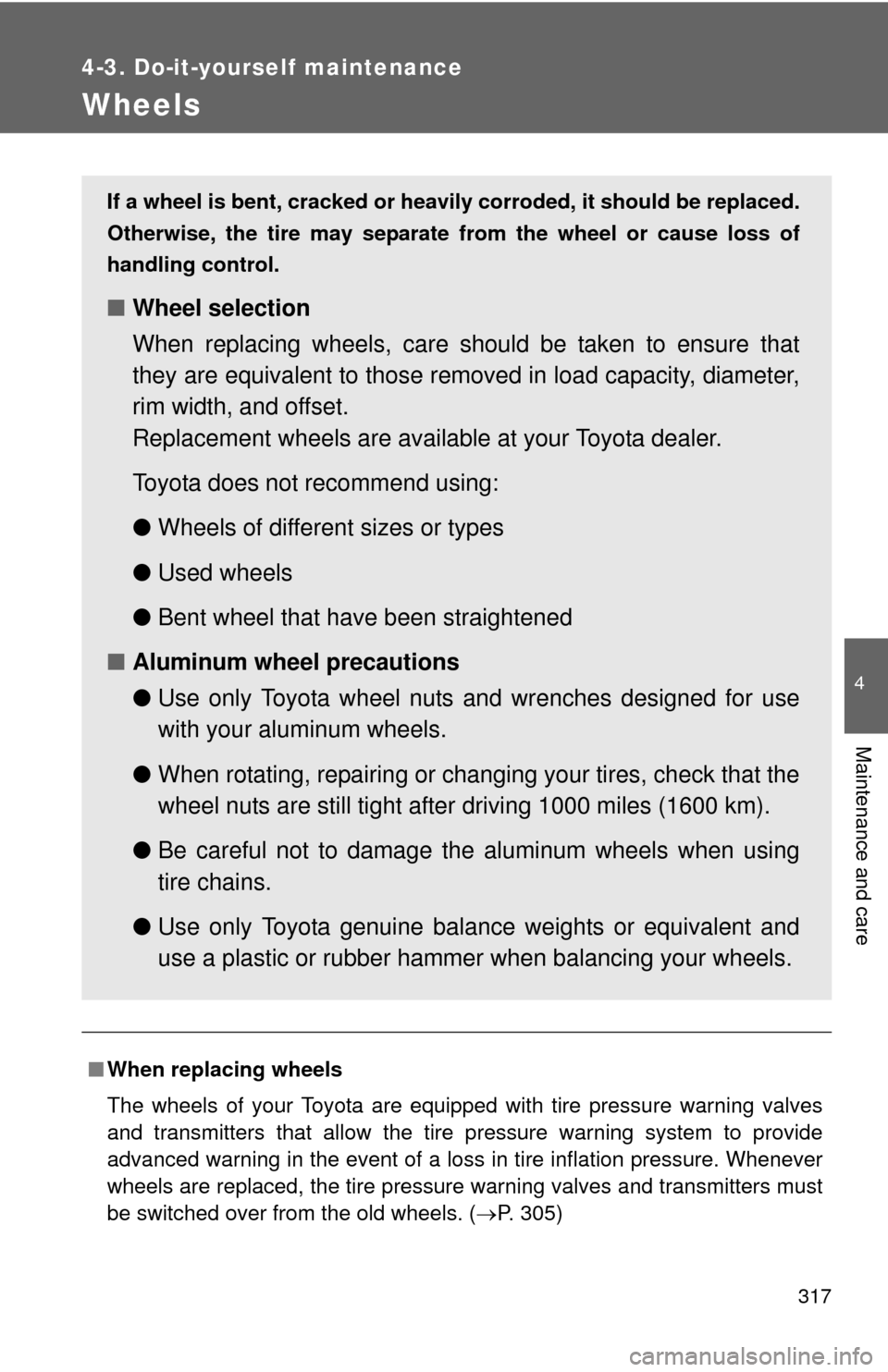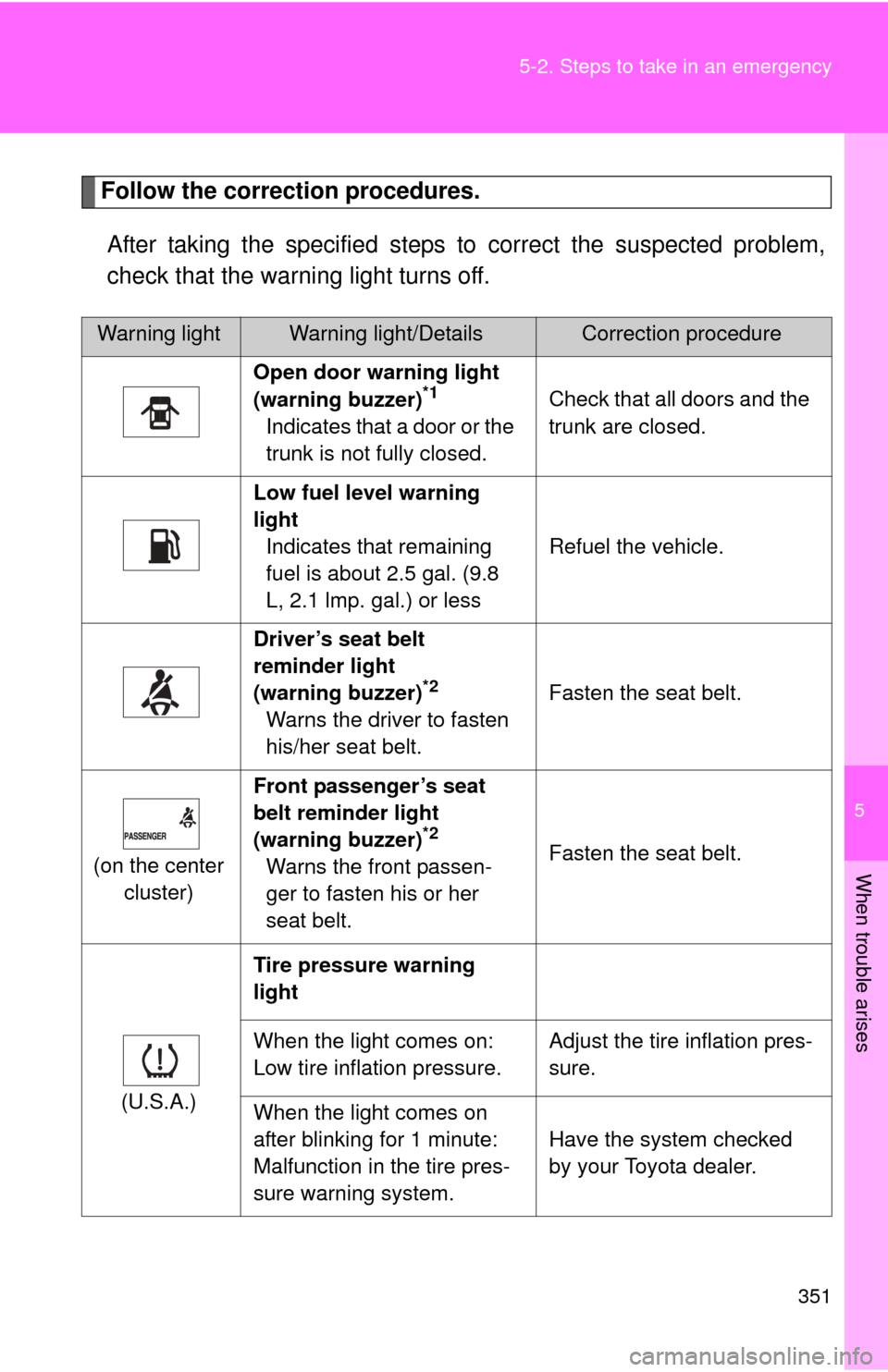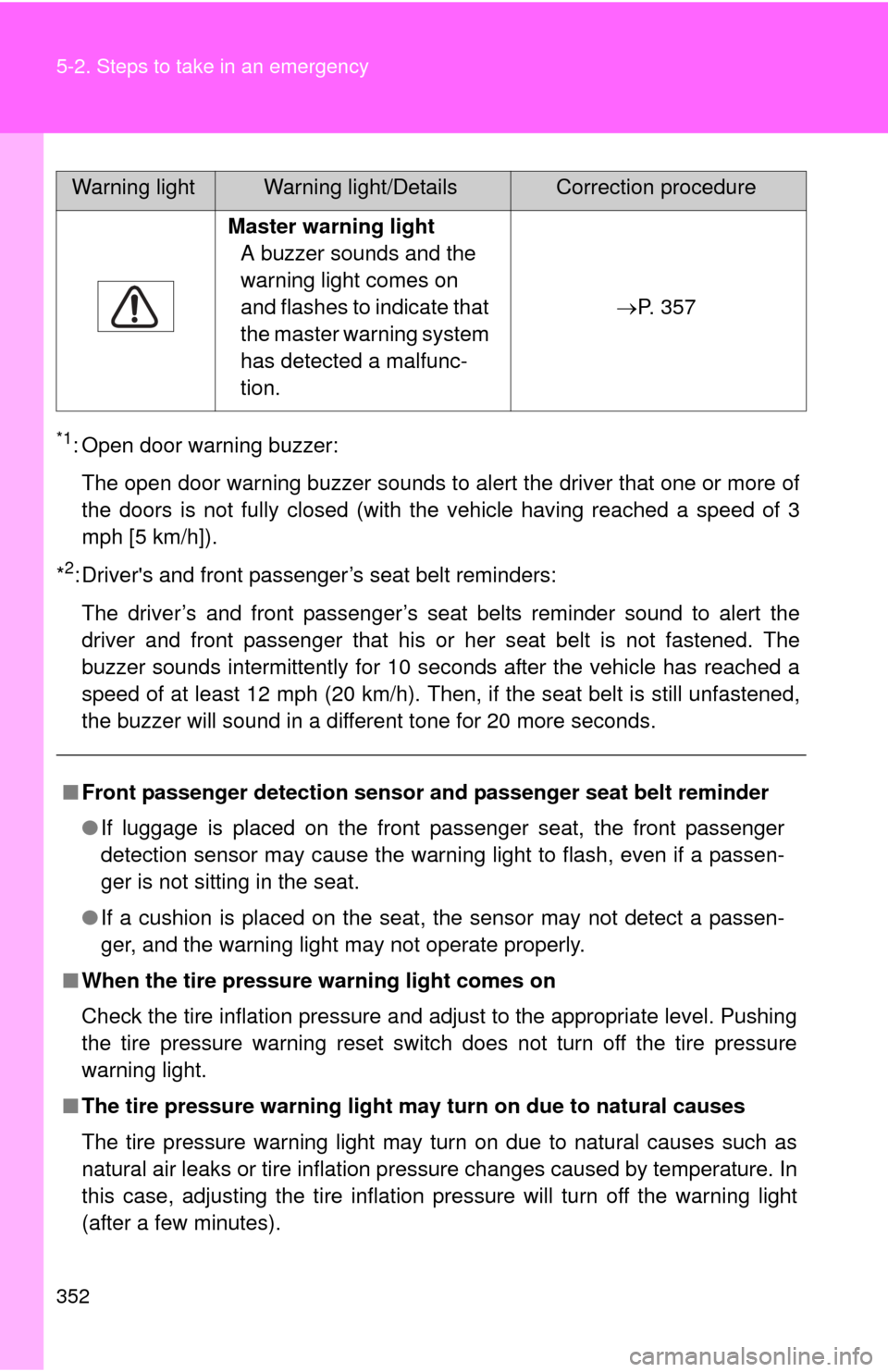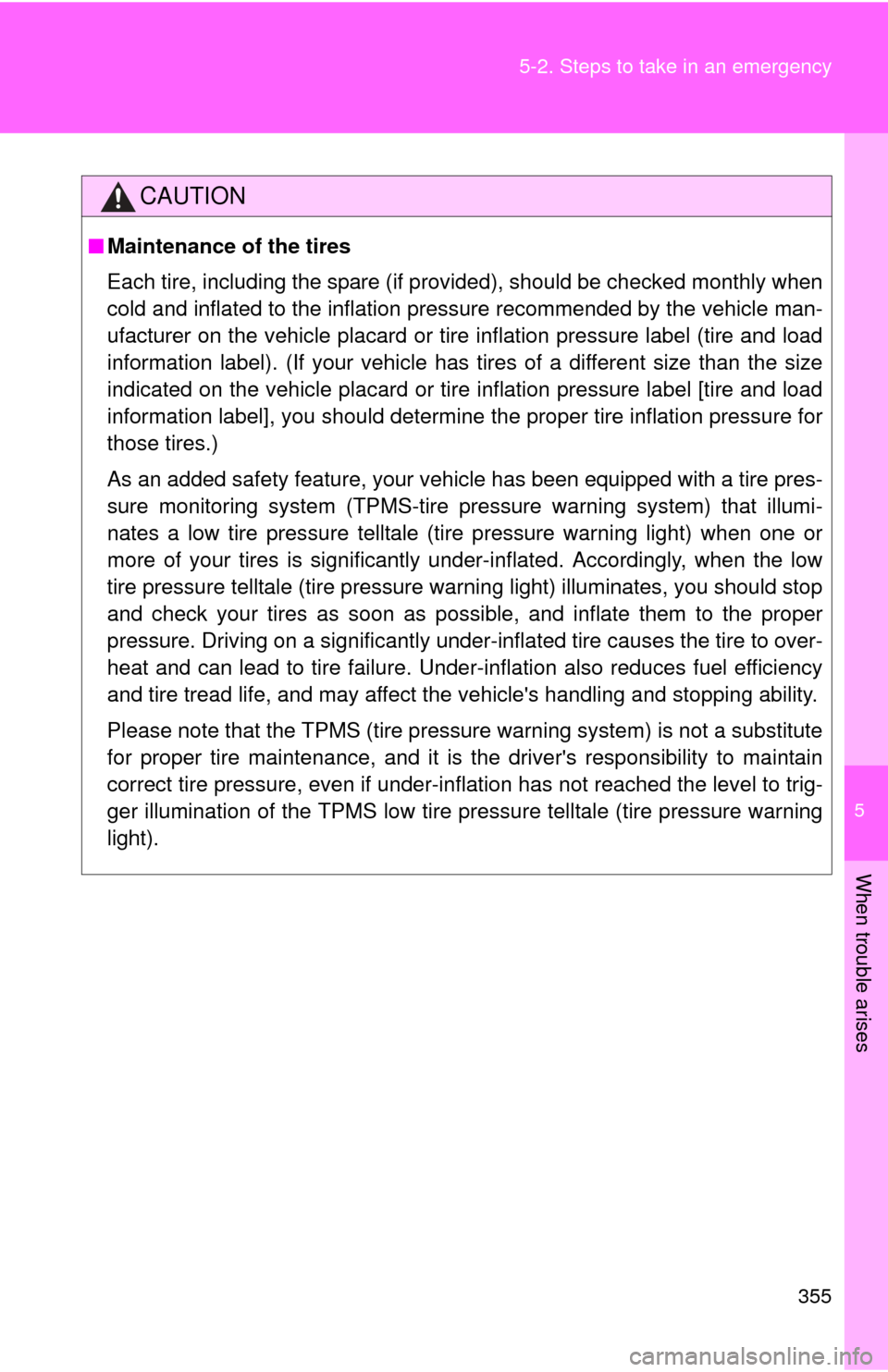Page 317 of 440

317
4-3. Do-it-yourself maintenance
4
Maintenance and care
Wheels
■When replacing wheels
The wheels of your Toyota are equipped with tire pressure warning valves
and transmitters that allow the tire pressure warning system to provide
advanced warning in the event of a loss in tire inflation pressure. Whenever
wheels are replaced, the tire pressure warning valves and transmitters must
be switched over from the old wheels. (P. 305)
If a wheel is bent, cracked or heavily corroded, it should be replaced.
Otherwise, the tire may separat e from the wheel or cause loss of
handling control.
■ Wheel selection
When replacing wheels, care should be taken to ensure that
they are equivalent to those removed in load capacity, diameter,
rim width, and offset.
Replacement wheels are available at your Toyota dealer.
Toyota does not recommend using:
●Wheels of different sizes or types
● Used wheels
● Bent wheel that have been straightened
■ Aluminum wheel precautions
●Use only Toyota wheel nuts and wrenches designed for use
with your aluminum wheels.
● When rotating, repairing or changing your tires, check that the
wheel nuts are still tight after driving 1000 miles (1600 km).
● Be careful not to damage the aluminum wheels when using
tire chains.
● Use only Toyota genuine bal ance weights or equivalent and
use a plastic or rubber hammer when balancing your wheels.
Page 351 of 440

5
When trouble arises
351
5-2. Steps to take in an emergency
Follow the correction procedures.
After taking the specified steps to correct the suspected problem,
check that the warning light turns off.
Warning lightWarning light/DetailsCorrection procedure
Open door warning light
(warning buzzer)
*1
Indicates that a door or the
trunk is not fully closed. Check that all doors and the
trunk are closed.
Low fuel level warning
light Indicates that remaining
fuel is about 2.5 gal. (9.8
L, 2.1 lmp. gal.) or less Refuel the vehicle.
Driver’s seat belt
reminder light
(warning buzzer)
*2
Warns the driver to fasten
his/her seat belt. Fasten the seat belt.
(on the center cluster) Front passenger’s seat
belt reminder light
(warning buzzer)
*2
Warns the front passen-
ger to fasten his or her
seat belt.
Fasten the seat belt.
(U.S.A.) Tire pressure warning
light
When the light comes on:
Low tire inflation pressure.
Adjust the tire inflation pres-
sure.
When the light comes on
after blinking for 1 minute:
Malfunction in the tire pres-
sure warning system. Have the system checked
by your Toyota dealer.
Page 352 of 440

352 5-2. Steps to take in an emergency
*1: Open door warning buzzer:The open door warning buzzer sounds to alert the driver that one or more of
the doors is not fully closed (with the vehicle having reached a speed of 3
mph [5 km/h]).
*
2: Driver's and front passenger’s seat belt reminders: The driver’s and front passenger’s seat belts reminder sound to alert the
driver and front passenger that his or her seat belt is not fastened. The
buzzer sounds intermittently for 10 seconds after the vehicle has reached a
speed of at least 12 mph (20 km/h). Then, if the seat belt is still unfastened,
the buzzer will sound in a different tone for 20 more seconds.
Master warning light A buzzer sounds and the
warning light comes on
and flashes to indicate that
the master warning system
has detected a malfunc-
tion. P. 3 5 7
■ Front passenger detect ion sensor and passenger seat belt reminder
● If luggage is placed on the front passenger seat, the front passenger
detection sensor may cause the warning light to flash, even if a passen-
ger is not sitting in the seat.
● If a cushion is placed on the seat, the sensor may not detect a passen-
ger, and the warning light may not operate properly.
■ When the tire pressure warning light comes on
Check the tire inflation pressure and adjust to the appropriate level. Pushing
the tire pressure warning reset switch does not turn off the tire pressure
warning light.
■ The tire pressure warning light m ay turn on due to natural causes
The tire pressure warning light may turn on due to natural causes such as
natural air leaks or tire inflation pressure changes caused by temperature. In
this case, adjusting the tire inflation pressure will turn off the warning light
(after a few minutes).
Warning lightWarning light/DetailsCorrection procedure
Page 353 of 440

5
When trouble arises
353
5-2. Steps to take in an emergency
■
When a tires is replaced with a spare tire
The compact spare tire is not equipped with the tire pressure warning valve
and transmitter. If a tire goes flat, the tire pressure warning light will not turn
off even though the flat tire is replaced with the spare tire. Replace the spare
tire with the repaired tire and adjust the proper tire inflation pressure.
The tire pressure warning light will turn off after a few minutes.
■ If the tire pressure warning system is inoperative
The tire pressure warning system may become inoperative in the following
conditions:
(When the condition becomes normal, the system will work properly.)
●If tires not equipped with tire pressure warning valves and transmitters
are used.
● If the ID code on the tire pressure warning valves and transmitters is not
registered in the tire pressure warning computer.
● If electronic devices or facilities using similar radio wave frequencies are
nearby.
● If a radio set at similar frequencies is in use in the vehicle.
● If there is a lot of snow or ice on the vehicle, in particular around the
wheels or wheel housings.
● If non-genuine Toyota wheels are used. (Even if you use Toyota wheels,
the tire pressure warning system may not work properly with some types
of tires.)
● If tire chains are used.
● If the tire inflation pressure is 73 psi (500 kPa, 5.1 kgf/cm
2 or bar) or
higher
■ If the tire pressure warning light comes on after blinking frequently for
1 minute
If the tire pressure warning light comes on after blinking frequently for 1
minute when the “POWER” switch is turned to ON mode, have it checked by
your Toyota dealer.
Page 354 of 440

354 5-2. Steps to take in an emergency
■Customization
The vehicle speed linked seat belt reminder buzzer can be disabled.
(P. 421)
However, Toyota recommends that the seat belt reminder buzzer be opera-
tional to alert the driver and front passenger that the seat belts are not fas-
tened.
CAUTION
■ If the tire pressure warning light comes on
Be sure to observe the following precautions. Failure to do so could cause
loss of vehicle control and result in death or serious injury.
●Stop your vehicle in a safe place as soon as possible. Adjust the tire infla-
tion pressure immediately.
● If the tire pressure warning light comes on even after tire inflation pressure
adjustment, it is probable that you have a flat tire. Check the tires. If the
tire is flat, change to the spare tire and have the flat tire repaired by the
nearest Toyota dealer.
● Avoid abrupt maneuvering and braking. If the vehicle tires deteriorate, you
could lose control of the steering wheel or the brakes.
■ If a blowout or sudden air leakage should occur
The tire pressure warning system may not activate immediately.
Page 355 of 440

5
When trouble arises
355
5-2. Steps to take in an emergency
CAUTION
■
Maintenance of the tires
Each tire, including the spare (if provided), should be checked monthly when
cold and inflated to the inflation pressure recommended by the vehicle man-
ufacturer on the vehicle placard or tire inflation pressure label (tire and load
information label). (If your vehicle has tires of a different size than the size
indicated on the vehicle placard or tire inflation pressure label [tire and load
information label], you should determine the proper tire inflation pressure for
those tires.)
As an added safety feature, your vehicle has been equipped with a tire pres-
sure monitoring system (TPMS-tire pressure warning system) that illumi-
nates a low tire pressure telltale (tire pressure warning light) when one or
more of your tires is significantly under-inflated. Accordingly, when the low
tire pressure telltale (tire pressure warning light) illuminates, you should stop
and check your tires as soon as possible, and inflate them to the proper
pressure. Driving on a significantly under-inflated tire causes the tire to over-
heat and can lead to tire failure. Under-inflation also reduces fuel efficiency
and tire tread life, and may affect the vehicle's handling and stopping ability.
Please note that the TPMS (tire pressure warning system) is not a substitute
for proper tire maintenance, and it is the driver's responsibility to maintain
correct tire pressure, even if under-inflation has not reached the level to trig-
ger illumination of the TPMS low tire pressure telltale (tire pressure warning
light).
Page 373 of 440
5
When trouble arises
373
5-2. Steps to take in an emergency
Lower the vehicle.
Firmly tighten each nut two or
three times in the order shown in
the illustration.
Tightening torque:
76 ft•lbf (103 N•m, 10.5 kgf•m)
Stow the flat tire, tire jack and all tools.
STEP3
STEP4
■
The compact spare tire
●The compact spare tire is identif ied by the label “TEMPORARY USE
ONLY” on the tire sidewall.
Use the compact spare tire temporarily only in an emergency.
● Make sure to check the tire pressure of the compact spare tire. ( P. 404)
■ When using the compact spare tire
As the compact spare tire is not equipped with the tire pressure warning
valve and transmitter, low inflation pressure of the spare tire will not be
warned. Also, if you replace the compact spare tire after the tire pressure
warning light comes on, the light remains on.
STEP5
Page 404 of 440
404 6-1. Specifications
Tires and wheels
Tire sizeP215/60R16 94V, T155/70D17 110M
Tire inflation pressure
(Recommended cold tire
inflation pressure)Driving under normal conditions
Front: 32 psi (220 kPa, 2.2 kgf/cm
2 or bar)*
Rear: 32 psi (220 kPa, 2.2 kgf/cm2 or bar)*
Spare: 60 psi (420 kPa, 4.2 kgf/cm2 or bar)
*: When driving at high speeds above 100 mph (160 km/h), in countries where such
speeds are permitted by law, add 3 psi
(20 kPa, 0.2 kgf/cm
2 or bar) to the front
tires and rear tires. Never exceed the
maximum cold tire inflation pressure
indicated on the tire sidewall.
Wheel size 16 6 1/2 J, 17 4 T (compact spare)
Wheel nut torque 76 ft•lbf (103 N•m, 10.5 kgf•m)